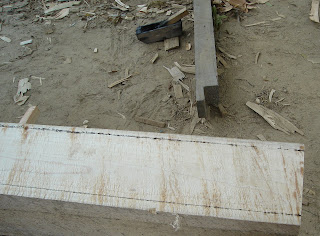What I thought would be a quick stop on the way to see the "real" Colonial Williamsburg turned out to be a really neat learning opportunity.
First we visited the oxen being yoked to till the field. We found that these oxen are a mix between a modern breed and the breed that would have come from Europe during Colonial times. These oxen were bred for hard work and compliance.
Then we made a stop to see some colonial construction. These men are working on rafters for a coffee house in the city that will replicate a building found in an archaeological dig. They order machine-cut lumber larger than what's needed in order to put on an authentic, hand-hewn finish. Sully got to help with the chalk line. They used a mixture of coal and water because they needed a dark line on the light wood. The amazing thing to me is that this technology- plumb and chalk lines- were used in Ancient Egypt, Colonial America and today.


Our trip to the slave quarters was very informative. We saw what a weeks worth of rations looked like- not much! Chickens were kept behind the slave homes and both master and slave ate the eggs. We also learned the origin of "hoe cakes". The gardens of slave and master were quite different. The master's garden held more European plants such as lavender and herbs and the slave's garden tended more toward African vegetables like okra, black-eyed peas and sweet potatoes.

We learned that on a farm such as this everyone of age would have worked, slave, master and child. Here is Nathan learning the most efficient way to grind corn.

Bricks and rock were expensive and hard to come by so the houses were built of wood and a stone or brick hearth was added. Since a masonry chimney was too costly, a wooden chimney was built because wood was abundant. The chimney was built off the house at an angle so if it were to catch fire, it could be pushed away from the house saving the dwelling.

Shown is the slave house, the master's house is the next to be built. We saw the posts set up and it is not much bigger than the slave house. Great Hopes Plantation shows a middle class plantation- a working farm with no luxuries.
We didn't make it back for the candle dipping but we did see the big kettle of melted wax over a constantly tended fire- it needed to stay lit but not too hot.
Check back for other posts on our trip. I decided to break them up since we did and saw so much.









1 comment:
Would you believe that all the time I've been reading your blog, I didn't know you could click on the photos and blow them up to a larger size? If I hadn't phoned your dad to wish him a happy anniversary, I still wouldn't know!
Post a Comment